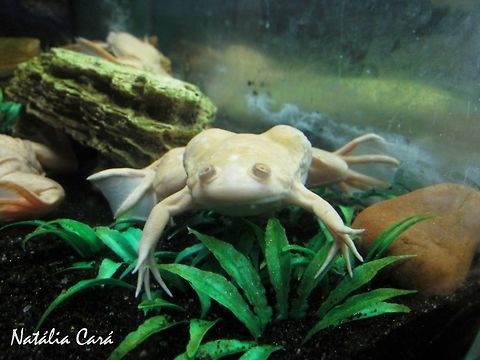
Appearance
These frogs are plentiful in ponds and rivers within the south-eastern portion of Sub-Saharan Africa. They are aquatic and are often greenish-grey in color. Albino varieties are commonly sold as pets. “Wild-type” African Clawed Frogs are also frequently sold as pets, and often incorrectly labeled as a Congo Frog or African Dwarf Frog because of similar colorings. They are easily distinguished from African Dwarf Frogs because African Clawed Frogs have webbing only on their hind feet while African Dwarf Frogs have webbing on all four feet. They reproduce by laying eggs . Also, the clawed frogs are the only amphibians to have actual claws.The average life-span of these frogs ranges from 5-15 years with some individuals recorded to have lived for 20–25 years. They shed their skin every season, and eat their own shedded skin.
Although lacking a vocal sac, the males make a mating call of alternating long and short trills, by contracting the intrinsic laryngeal muscles. Females also answer vocally, signaling either acceptance or rejection of the male. This frog has smooth slippery skin which is multicolored on its back with blotches of olive gray or brown. The underside is creamy white with a yellow tinge.
Male and female frogs can be easily distinguished through the following differences. Male frogs are usually about 20% smaller than females, with slim bodies and legs. Males make mating calls to attract females, sounding very much like a cricket calling underwater. Females are larger than the males, appearing far more plump with hip-like bulges above their rear legs . While they do not sing or call out like males do, they do answer back .
Both males and females have a cloaca, which is a chamber through which digestive and urinary wastes pass and through which the reproductive systems also empty. The cloaca empties by way of the vent which in reptiles and amphibians is a single opening for all three systems.

Uses
''Xenopus laevis'' have been kept as pets and research subjects since as early as the 1950s. They are extremely hardy and long lived, having been known to live up to 20 or even 30 years in captivity.African Clawed Frogs are frequently mislabeled as African Dwarf Frogs in pet stores. The astute pet owner will recognize the difference, however, because of the following characteristics:
⤷ Dwarf frogs have four webbed feet. African Clawed Frogs have webbed hind feet while their front feet have autonomous digits.
⤷ African Dwarf Frogs have eyes positioned on the side of their head, while African Clawed Frogs have eyes on the top of their heads
⤷ African Clawed Frogs have curved, flat snouts. The snout of an African Dwarf Frog is pointed.
They are as easy to take care of as fish.
References:
Some text fragments are auto parsed from Wikipedia.